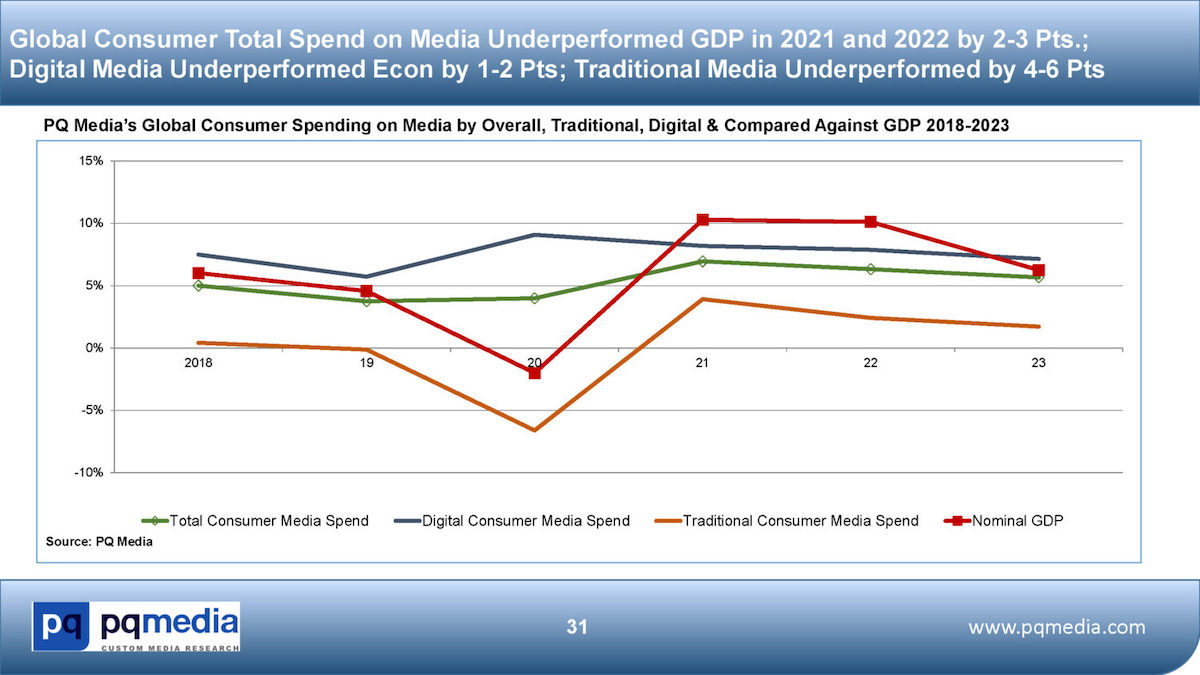
Global Consumer Media Content And Tech Spend Grew 6.3% In 2022, Slowing Down From 2021
May 11, 2023 by Dave Haynes
Global consumer spending on overall media content and technology decelerated in 2022 from the rate of a year earlier, but still grew by 6.3%, according to new research by PQ Media. Overall spend in 2022 was $2.186 trillion.
The research doesn’t get into detail, at least not in PQ’s summary, but does provide insight into the broader state.
Despite the relatively solid gain in 2022, the growth of consumer media spending – much like consumer media usage – began to decelerate in 2022, as expenditures on major digital and traditional media subscriptions, access and devices slowed considerably during the year, according to the Global Consumer Spending on Media Forecast 2023-2027.
The research highlights and narrative:
Global consumer spending on overall media content grew 10.8% in 2022 to $930.66 billion, while total media-related technology spend rose 3.3% to $1.255 trillion. Consumer spend on digital media content and tech worldwide increased 7.9% in 2022 to $1.589 trillion, while end-user spend on traditional media content and tech was up 2.4% to $596.74 billion.
The United States remained the largest consumer media and tech market in the world with total spending of $509.74 billion in 2022, while South Africa was the fastest growing of the Top-20 markets, rising 9.8%. Global consumers spent an average of $374.36 on all media content and tech in 2022, a 5.7% gain over 2021, of which $272.17 was spent on digital media and $102.19 on traditional media, according to the according to the Global Consumer Spending on Media Forecast 2023-2027.
PQ Media’s research, however, indicates that the solid growth exhibited in 2022 was skewed by the high double-digit gain in movie admissions around the world as consumers returned to theaters after the steep decline in pandemic-struck 2020, when many cineplexes were shuttered.
“PQ Media projects consumer media and tech expenditures will lose even more steam during the 2023-2027 period, as the pandemic-driven forces that sparked unexpected spending surges in many media and tech categories in 2020-2021 continue to fade,” says PQ Media CEO Patrick Quinn. “While the pandemic effect briefly interrupted key secular trends in that two-year period, this was simply a near-term disruption of long-term industry trends that will continue over the next several years, resulting in slower growth or outright declines across various digital and traditional media content and tech categories.”
In addition, macroeconomic headwinds, such as inflation, interest rate hikes, regional banking failures and geopolitical tensions, have led many consumers to trim discretionary spending budgets. For example, broadband internet access, computer tablets, DVD players, pay-per-view and print book clubs posted their lowest growth rates ever in 2022. Economic uncertainty led to end-user spend being curtailed on items that posted growth spikes during the pandemic, such as streaming video services and print books.
Also contributing to the decelerating growth in 2022 was a return to normal behaviors. Students went back to the classroom, reducing the need to upgrade various digital technology to accommodate remote learning, such as new laptops, tablets and smartphones. Similarly, many workers were required to return to corporate offices in 2022, diminishing the need for new home offices that required new PCs, home audio systems and higher-speed broadband access.
Going forward, pre-pandemic secular trends are re-emerging that directly link consumer media usage to consumer media spending, in which major global events like the Olympics, World Cup and political elections drive up spending growth in even years, followed by decelerated growth in odd years. Media content and tech categories impacted by these long-term trends include single-copy newspaper and magazine sales, video-on-demand and digital video downloads, and television set and smart speaker upgrades, per PQ Media.
Additionally, some media content and tech are simply becoming obsolete, primarily due to improved distribution methods and/or the shift to newer digital media platforms. A number of countries, for instance, reported that there would be no more dial-up internet access in 2022 or 2023. Other categories being impacted include feature mobile cell phones, music and book CDs, and movie and television DVDs.
On a positive note, besides the movie industry rebound, the videogame industry isn’t being hampered by issues that limited the availability of new gaming console upgrades and related accessories in 2020-2021, such as virtual reality headgear. Factories in Taiwan and elsewhere increased the number of manufacturing facilities in 2022 and 2023 to try to keep up with high demand for chips, while seaports and trucking companies worldwide began to report fewer supply chain delays.
Other highlights from the new PQ Media Forecast include:
- Pure-play mobile media was the largest of the 10 hybrid-media silo spending categories in 2022 at $522.87 billion, while movies was the fastest growing, rising 16.3%;
- Wireless data subscriptions was the largest of the 28 digital media categories in 2022 at $266.74 billion, while digital audio streaming and satellite radio posted the fastest growth, up 27.2%;
- Basic and premium TV subscriptions was the largest of the 14 traditional media categories in 2022 at $227.13 billion, and movie admissions and home video discs registered the strongest growth, increasing 30%;
- Among the top-20 global markets, Russia ranked first in digital media’s share of overall content and tech spending in 2022 at 84.4%, as Japan ranked first in average consumer expenditures on all media at $1,648.98;
- Global consumer spending on total media content and tech is forecast to rise 5.7% in 2023, while the US market is projected to register a 4.5% gain.



Leave a comment